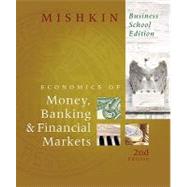The Economics of Money, Banking, and Financial Markets set the standard for money and banking courses when it published in its first edition, and it continues to be the worldwide market leader. The historic economic events and financial crises of late 2008 have changed the entire landscape of money and banking. Having just served as Governor of the Federal Reserve, only Mishkin has the unique insider's perspective needed to present the current state of money and banking and explain the latest debates and issues for today’s readers. For professors who teach with less emphasis on monetary theory and prefer to focus more time on financial institutions, the Business School Edition is the ideal alternative.
Introduction: Why Study Money, Banking, and Financial Markets?; An Overview of the Financial System; What Is Money?
Financial Markets: Understanding Interest Rates; The Behavior of Interest Rates; The Risk and Term Structure of Interest Rates; The Stock Market, the Theory of Rational Expectations, and the Efficient Market Hypothesis. Financial Institutions: An Economic Analysis of Financial Structure; Financial Crises and the Subprime Debacle; Banking and the Management of Financial Institutions; Economic Analysis of Financial Regulation; Banking Industry: Structure and Competition; Nonbank Finance; Financial Derivatives; Conflicts of Interest in the Financial Industry. Central Banking and the Conduct of Monetary Policy: Structure of Central Banks and the Federal Reserve System; The Money Supply Process; Tools of Monetary Policy; What Should Central Banks Do? Monetary Policy Goals, Strategy, and Tactics. International Finance and Monetary Policy: The Foreign Exchange Market; The International Financial System. Monetary Policy: The Demand for Money; Aggregate Demand and Supply Analysis; Transmission Mechanisms of Monetary Policy: The Evidence; Money and Inflation.
For all readers interested in money, banking, and financial markets.
“Mishkin is by far the most complete and concise reference on the market for students taking financial economics and monetary policy courses.”–J. Reynolds, Northern Illinois University
“The quality of the writing style and the updated coverage of topics make this a great book.”–Phillip Lane, Fairfield University
“I have my students telling me at the end of the semester [that] they have enjoyed reading the book.”–Alla A. Melkumian, Western Illinois University
“Mishkin is relevant, challenging, and interesting. It provides clear explanations of monetary theory and policy. It is up-to-date. The Federal Reserve material features an insider’s perspective.”–Linda Hooks, Washington and Lee University
“The use of economic analysis gives students a deeper understanding and attracts their interest. The extensive presentation of charts appeals to visual learners and the associated PowerPoint slides give instructors useful visual aids for classroom lectures.”–Fiona Mclachlan, Manhattan College








